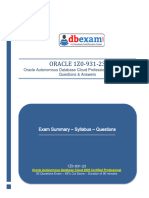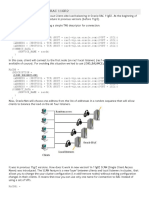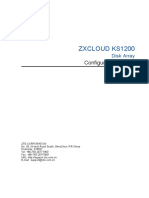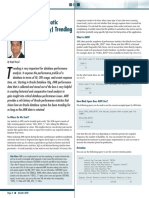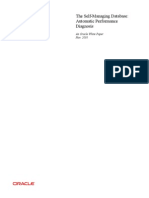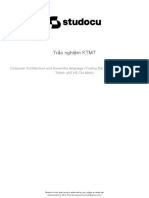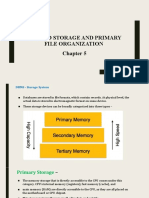Oracle DBA Job Interview Questions and Answers
Uploaded by
Tryscribb NewOracle DBA Job Interview Questions and Answers
Uploaded by
Tryscribb NewOracle DBA Job Interview
Questions And Answers
Interview Questions Answers
https://interviewquestionsanswers.org/
About Interview Questions Answers
Interview Questions Answers . ORG is an interview preparation guide of thousands of Job
Interview Questions And Answers, Job Interviews are always stressful even for job seekers who have
gone on countless interviews. The best way to reduce the stress is to be prepared for your job
interview. Take the time to review the standard interview questions you will most likely be asked.
These interview questions and answers on Oracle DBA will help you strengthen your technical skills,
prepare for the interviews and quickly revise the concepts.
If you find any question or answer is incorrect or incomplete then you can submit your question or
answer directly with out any registration or login at our website. You just need to visit Oracle DBA
Interview Questions And Answers to add your answer click on the Submit Your Answer links on the
website; with each question to post your answer, if you want to ask any question then you will have a
link Submit Your Question; that's will add your question in Oracle DBA category. To ensure quality,
each submission is checked by our team, before it becomes live. This Oracle DBA Interview
preparation PDF was generated at Saturday 6th February, 2021
You can follow us on FaceBook for latest Jobs, Updates and other interviews material.
www.facebook.com/InterviewQuestionsAnswers.Org
Follow us on Twitter for latest Jobs and interview preparation guides.
https://twitter.com/InterviewQA
If you need any further assistance or have queries regarding this document or its material or any of
other inquiry, please do not hesitate to contact us.
Best Of Luck.
Interview Questions Answers.ORG Team
https://InterviewQuestionsAnswers.ORG/
Support@InterviewQuestionsAnswers.ORG
Oracle DBA Interview Questions And Answers
In
te
Oracle DBA Interview Questions And Answers Guide.
rv
ie
w
Q
Question - 1:
Explain FORCE LOGGING feature in 9i.
ue
Ans:
By setting FORCE LOGGING to TRUE, all transactions will generate REDO. This is used for Data Guard, so no data will be missed (i.e. transactions that were run
with NOLOGGING option) in Standby database
st
View All Answers
Question - 2:
io
How can you tell if an index on particular table is USED or NOT USED in 9i?
Ans:
ns
By turning MONITORING ON that index and querying into INDEX_USAGE table
View All Answers
Question - 3:
A
How do you put database is ARCHIVELOG mode, explain procedure?
Ans:
ns
1. Modify init.ora parameter START_ARCHIVE=TRUE
2. SQL> SHUTDOWN IMMEDIATE;
3. STARTUP MOUNT;
4. ALTER DATAVASE ARCHIVELOG;
w
5. ALTER DATABASE OPEN;
View All Answers
er
Question - 4:
If you had a tablespace, TEST_TABLESPACE, which consists of three files:
s.
TEST01.dbf, TEST02.dbf, and TEST03.dbf, and someone accidentally used the Unix command
"rm" to delete the file TEST02.dbf, what else would you need in order to recover all the data that
was present in TEST_TABLESPACE at the time that TEST02.dbf was deleted?
O
Ans:
All Archivelogs
R
View All Answers
G
Question - 5:
Explain procedure to Change CHARACTERSET of a database.
Ans:
Can't change CHARACTERSET of a database, you will need to re-create the database with
appropriate CHARACTERSET.
View All Answers
Question - 6:
You see a wait on LMS process in statspack, what does that mean?
Ans:
Wait is due to Data Guard Broker.
View All Answers
Question - 7:
Copyright © https://InterviewQuestionsAnswers.org Page 3/10
Oracle DBA Interview Questions And Answers
How do you analyze table partition using Oracle provided package?
Ans:
DBMS_STATS.GATHER_TABLE_STATS with GRANULARITY => 'PARTITION' OPTION
In
View All Answers
Question - 8:
te
What is PGA_AGGREGATE_TARGET?
Ans:
rv
This parameter controls the maximum amount of memory PGA which can be used by the queries when WORKAREA_SIZE_POLICY is set to Auto.
The value you can be set in Bytes, kilobytes (K), megabytes (M) or gigabytes (G). The default value is 0
This parameter also has an effect on the execution plans of the cost based optimizer. The optimizer uses the value of the parameter PGA_AGGREGATE_TARGET to
derive an estimate
ie
for the minimum and maximum amount of memory which should be available at run-time for each sort, hash-join and bitmap operator in the query. Based on this
minimum and maximum value, the
optimizer selects the best plan.
w
View All Answers
Question - 9:
Q
List five most important parameter in 9i affecting performance?
Ans:
ue
CURSOR_SHARING
DB_CACHE_SIZE
PGA_AGGREGATE_TARGET
DB_16K_CACHE_SIZE, DB_8K_CACHE_SIZE, DB_2K_CACHE_SIZE
st
View All Answers
io
Question - 10:
Explain below wait events in STATSPACK report DB SCATTERED READ, DB SEQUENTIAL REAL, ENQUEUE?
ns
Ans:
DB SCATTERED READ - FULL TABLE SCAN
DB SEQUENTIAL REAL - IO
ENQUEUE - LOCKING
View All Answers
A
Question - 11:
ns
Process you follow to start looking into Performance issue at database level
(If the application is running very slow, at what points do you need to go about the database in
order to improve the performance?)
w
Ans:
* Run a TOP command in Unix to see CPU usage (identify CPU killer processes)
* Run VMSTAT, SAR, and PRSTAT command to get more information on CPU and memory usage and possible blocking
er
* Run STATSPACK report to identify:
1. TOP 5 WAIT EVENTS
2. RESOURCE intensive SQL statements
s.
* See if STATISTICS on affected tables needs to be re-generated
* IF poorly written statements are culprit, run a EXPLAIN PLAN on these statements and see whether new index or use of HINT brings the cost of SQL down.
View All Answers
O
Question - 12:
R
How do you install Statspack?
Ans:
G
By running $ORACLE_HOME/rdbms/admin/spcreate.sql script
View All Answers
Question - 13:
Which RMAN command is used to create an exact replica of a database in
new host?
Ans:
DUPLICATE DATABASE
View All Answers
Question - 14:
A DBA had to remove some Archivelogs to free up space in filesystem. Now
when the RMAN job starts to backup Archivelogs, it complains about missing Archivelogs that
were deleted by DBA. To resolve the issue and continue backing up remainder of Archivelogs,
which RMAN command can be used so it wo not complain about missing Archivelogs.
Copyright © https://InterviewQuestionsAnswers.org Page 4/10
Oracle DBA Interview Questions And Answers
Ans:
Crosscheck command
View All Answers
In
Question - 15:
what is the difference between group by and order by?
te
Ans:
group by is used when we use aggregate functions on the columns in a query the other columns
should be in group by query
rv
example:
select empno,ename,sum(sal) from emp
group by empno,ename
ie
Order by is used to sort values either in ascending or descending order
View All Answers
w
Question - 16:
How would you pass hints to the SQL processor?
Q
Ans:
USING COMMENT LINES WITH (+) SIGN YOU CAN PASS THE HINTS TO SQL ENGINE
For example
ue
/* +PARALLEL( ) */
View All Answers
st
Question - 17:
Do you need a commit after DDL statements?
Ans:
io
DDL IS A AUTO COMMIT, YOU DON􀂶T NEED TO COMMIT AGAIN
View All Answers
ns
Question - 18:
What are the steps involved in Instance Recovery in Oracle?
Ans:
A
Rolling forward to recover data that has not been recorded in data files, yet has been recorded
in the on-line redo log, including the contents of rollback segments.
ns
Rolling back transactions that have been explicitly rolled back or have not been committed as
indicated by the rollback segments regenerated in step a.
Releasing any resources (locks) held by transactions in process at the time of the failure.
Resolving any pending distributed transactions undergoing a two-phase commit at the time of
the instance failure.
w
View All Answers
er
Question - 19:
What is Oracle Log Switch?
s.
Ans:
The point at which ORACLE ends writing to one online redo log file and begins writing to another
is called a log switch.
O
View All Answers
R
Question - 20:
What are the advantages of operating a database in ARCHIVELOG mode
G
over operating it in NO ARCHIVELOG mode?
Ans:
Complete database recovery from disk failure is possible only in ARCHIVELOG mode.
Online database backup is possible only in ARCHIVELOG mode.
View All Answers
Question - 21:
What is Oracle Archived Redo Log?
Ans:
Archived Redo Log consists of Redo Log files that have archived before being reused.
View All Answers
Question - 22:
What is Oracle Partial Backup?
Copyright © https://InterviewQuestionsAnswers.org Page 5/10
Oracle DBA Interview Questions And Answers
Ans:
A Partial Backup is any operating system backup short of a full backup, taken while the
database is open or shut down.
View All Answers
In
Question - 23:
te
What is Oracle Full Backup?
Ans:
A full backup is an operating system backup of all data files, on-line redo log files and control
rv
file that constitute ORACLE database and the parameter.
View All Answers
ie
Question - 24:
What are the different modes of mounting a Database with the Parallel
w
Server?
Ans:
Exclusive Mode If the first instance that mounts a database does so in exclusive mode, only
Q
that Instance can mount the database.
Parallel Mode If the first instance that mounts a database is started in parallel mode, other
instances that are started in parallel mode can also mount the database.
ue
View All Answers
Question - 25:
st
What are the steps involved in Database Start up?
Ans:
io
Start an instance, Mount the Database and Open the Database.
View All Answers
ns
Question - 26:
What operator tests column for the absence of data?
Ans:
IS NULL operator
A
View All Answers
ns
Question - 27:
Which function is used to find the largest integer less than or equal to a
specific value?
w
Ans:
FLOOR
er
View All Answers
Question - 28:
s.
What is the advantage of specifying WITH GRANT OPTION in the GRANT
command?
O
Ans:
The privilege receiver can further grant the privileges he/she has obtained from the owner to any
other user.
R
View All Answers
G
Question - 29:
Which date function is used to find the difference between two dates?
Ans:
MONTHS_BETWEEN
View All Answers
Question - 30:
What is the use of the DROP option in the ALTER TABLE command?
Ans:
It is used to drop constraints specified on the table.
View All Answers
Question - 31:
Copyright © https://InterviewQuestionsAnswers.org Page 6/10
Oracle DBA Interview Questions And Answers
What operator performs pattern matching
Ans:
LIKE operator
In
View All Answers
Question - 32:
te
How do I write a cron which will run a SQL query and mail the results to a
group?
rv
Ans:
Use DBMS_JOB for scheduling a cron job and DBMS_MAIL to send the results through email.
View All Answers
ie
Question - 33:
w
what is difference between Co-related sub query and nested sub query?
Ans:
Co-related sub query is one in which inner query is evaluated only once and from that result outer
Q
query is evaluated.
Nested query is one in which Inner query is evaluated for multiple times for getting one row of that
outer query.
ue
ex. Query used with IN() clause is Co-related query.
Query used with = operator is Nested query
View All Answers
st
Question - 34:
What is the difference between RAID 5 and RAID 10? Which is better for Oracle?
io
Ans:
RAID 5 is striping with an extra disk for parity. If we lose a disk we can reconstruct from that parity disk.
RAID 10 is mirroring pairs of disks, and then striping across those sets.
ns
RAID 5 was created when disks were expensive. Its purpose was to provide RAID on the cheap. If a disk fails, the IO subsystem will perform VERY slowly during
the rebuild process. What's more your liklihood of failure increases dramatically during this period, with all the added weight of the rebuild. Even when it is operating
normally RAID 5 is slow for everything but reading. Given that and knowing databases (especially Oracle's redo logs) continue to experience write activity all the
time, we should avoid RAID5 in all but the rare database that is MOSTLY read activity. Don't put redologs on RAID5.
RAID10 is just all around goodness. If you lose one disk in a set of 10 for example, you could lose any one of eight other disks and have no troubles. What's more
A
rebuilding does not impact performance at all since you're simply making a mirror copy. Lastly RAID10 perform exceedingly well in all types of databases.
View All Answers
ns
Question - 35:
What are the tradeoffs between many vs few indexes? When would you want to have many, and when would it be better to have fewer?
w
Ans:
Fewer indexes on a table mean faster inserts/updates. More indexes mean faster, more specific WHERE clauses possibly without index merges.
View All Answers
er
Question - 36:
s.
Why is SQL*Loader direct path so fast?
Ans:
O
SQL*Loader with direct path option can load data ABOVE the high water mark of a table, and DIRECTLY into the datafiles, without going through the SQL engine
at all. This avoids all the locking, latching, and so on, and doesn't impact the db (except possibly the I/O subsystem) at all.
View All Answers
R
Question - 37:
G
In PL/SQL, what is bulk binding, and when/how would it help performance?
Ans:
Oracle's SQL and PL/SQL engines are separate parts of the kernel which require context switching, like between unix processes. This is slow, and uses up resources.
If we loop on an SQL statement, we are implicitely flipping between these two engines. We can minimize this by loading our data into an array, and using PL/SQL
bulk binding operation to do it all in one go!
View All Answers
Question - 38:
What are bind variables and why are they important?
Ans:
With bind variables in SQL, Oracle can cache related queries a single time in the SQL cache (area). This avoids a hard parse each time, which saves on various
locking and latching resources we use to check objects existence and so on. BONUS: For rarely run queries, especially BATCH queries, we explicitely DO NOT
want to use bind variables, as they hide information from the Cost Based Opitmizer.
BONUS BONUS: For batch queries from 3rd party apps like peoplesoft, if we can't remove bind variables, we can use bind variable peeking!
View All Answers
Copyright © https://InterviewQuestionsAnswers.org Page 7/10
Oracle DBA Interview Questions And Answers
Question - 39:
What is the difference between RMAN and a traditional hotbackup?
Ans:
In
RMAN is faster, can do incremental (changes only) backups, and does not place tablespaces into hotbackup mode.
View All Answers
te
Question - 40:
Tell me about standby database? What are some of the configurations of it? What should we watch out for?
rv
Ans:
Standby databases allow us to create a copy of our production db, for disaster recovery. We merely switch mode on the target db, and bring it up as read/write. Can
setup as master->slave or master->master. The latter allows the former prod db to become the standby, once the failure cause is remedied. Watch out for NO
ie
LOGGING!! Be sure we're in archivelog mode.
View All Answers
w
Question - 41:
What does the NO LOGGING option do? Why would we use it? Why would we be careful of using it?
Q
Ans:
It disables the logging of changes to the redologs. It does not disable ALL LOGGING, however as Oracle continues to use a base of changes, for recovery if you pull
the plug on the box, for instance. However it will cause problems if you are using standby database. Use it to speed up operations, like an index rebuild, or partition
ue
maintenance operations.
View All Answers
st
Question - 42:
What is the difference between a materialized view (snapshot) fast refresh versus complete refresh? When is one better, and when the other?
Ans:
io
Fast refresh maintains a change log table, which records change vectors, not unlike how the redo logs work. There is overhead to this, as with a table that has a LOT
of indexes on it, and inserts and updates will be slower. However if you are performing refreshes often, like every few minutes, you want to do fast refresh so you
don't have to full-table-scan the source table. Complete refresh is good if you're going to refresh once a day. Does a full table scan on the source table, and recreats the
ns
snapshot/mview. Also inserts/updates on the source table are NOT impacted on tables where complete refresh snapshots have been created.
View All Answers
Question - 43:
A
What is the difference between Truncate and Delete? Why is one faster?
Can we ROLLBACK both? How would a full table scan behave after?
ns
Ans:
Truncate is nearly instantaenous, cannot be rolled back, and is fast because Oracle simply resets the HWM. When a full table scan is performed on a table, such as for
a sort operation, Oracle reads to the HWM. So if you delete every single solitary row in 10 million row table so it is now empty, sorting on that table of 0 rows would
still be extremely slow.
w
View All Answers
er
Question - 44:
What is your favorite tool for day-to-day Oracle operation?
s.
Ans:
Hopefully we hear some use of command line as the answer!
View All Answers
O
Question - 45:
R
Name three SQL operations that perform a SORT.
Ans:
G
a. CREATE INDEX
b. DISTINCT
c. GROUP BY
d. ORDER BY
f. INTERSECT
g. MINUS
h. UNION
i. UNINDEXED TABLE JOIN
View All Answers
Question - 46:
Explain two easy SQL optimizations.
Ans:
a. EXISTS can be better than IN under various conditions
b. UNION ALL is faster than UNION (not sorting)
Copyright © https://InterviewQuestionsAnswers.org Page 8/10
Oracle DBA Interview Questions And Answers
View All Answers
Question - 47:
In
How do you use automatic PGA memory management with Oracle 9i and above?
Ans:
Set the WORKAREA_SIZE_POLICY parameter to AUTO and set PGA_AGGREGATE_TARGET
te
View All Answers
rv
Question - 48:
When using Oracle export/import what character set concerns might come up? How do you handle them?
Ans:
ie
Be sure to set NLS_LANG for example to "AMERCIAN_AMERICA.WE8ISO8859P1". If your source database is US7ASCII, beware of 8-bit characters. Also be
wary of multi-byte characters sets as those may require extra attention. Also watch export/import for messages about any "character set conversions" which may
w
occur.
View All Answers
Q
ue
st
io
ns
A
ns
w
er
s.
O
R
G
Copyright © https://InterviewQuestionsAnswers.org Page 9/10
Oracle Most Popular & Related Interview Guides
1 : Oracle PL-SQL Interview Questions and Answers.
2 : Oracle D2K Interview Questions and Answers.
3 : Forms Reports Interview Questions and Answers.
4 : Oracle AOL Interview Questions and Answers.
5 : Database Management Interview Questions and Answers.
6 : Oracle DB Optimization Interview Questions and Answers.
7 : SQL Plus Interview Questions and Answers.
8 : Oracle Developer Interview Questions and Answers.
9 : Oracle Database Interview Questions and Answers.
10 : Oracle Scenarios Interview Questions and Answers.
Follow us on FaceBook
www.facebook.com/InterviewQuestionsAnswers.Org
Follow us on Twitter
https://twitter.com/InterviewQA
For any inquiry please do not hesitate to contact us.
Interview Questions Answers.ORG Team
https://InterviewQuestionsAnswers.ORG/
support@InterviewQuestionsAnswers.ORG
You might also like
- Oracle 1Z0 931 23 Questions and Answers PDFNo ratings yetOracle 1Z0 931 23 Questions and Answers PDF9 pages
- Apache Cassandra Administrator Associate - Exam Practice TestsFrom EverandApache Cassandra Administrator Associate - Exam Practice TestsNo ratings yet
- Oracle DBA Interview Questions Experienced CandidateNo ratings yetOracle DBA Interview Questions Experienced Candidate6 pages
- OCI Exam Sample Questions 1 Training - Answers PDFNo ratings yetOCI Exam Sample Questions 1 Training - Answers PDF5 pages
- Migrate From Oracle To Postgresql With Azure: Webinar SeriesNo ratings yetMigrate From Oracle To Postgresql With Azure: Webinar Series21 pages
- Veritas Netbackup 6.5 For Oracle For Solaris PDFNo ratings yetVeritas Netbackup 6.5 For Oracle For Solaris PDF1 page
- ZXCLOUD KS1200 (V1.0) Disk Array Configuration GuideNo ratings yetZXCLOUD KS1200 (V1.0) Disk Array Configuration Guide130 pages
- Ee PDF V2019-May-17 by Theobald 40q VceNo ratings yetEe PDF V2019-May-17 by Theobald 40q Vce12 pages
- APPS DBA Interview Questions - Oracle DBANo ratings yetAPPS DBA Interview Questions - Oracle DBA39 pages
- Oracle 1z0 083 Dumps by Stephens 24-05-2024 7qa BraindumpscollectionNo ratings yetOracle 1z0 083 Dumps by Stephens 24-05-2024 7qa Braindumpscollection9 pages
- Theory Questions: Finalexam. Write Down The Command That You Have Used Inside The Terminal ToNo ratings yetTheory Questions: Finalexam. Write Down The Command That You Have Used Inside The Terminal To1 page
- Oracle AWR (Automatic Workload Repository) TrendingNo ratings yetOracle AWR (Automatic Workload Repository) Trending6 pages
- Oracle OCI Training and Certification Oracle Un…No ratings yetOracle OCI Training and Certification Oracle Un…1 page
- Oracle Database 10g - Automatic Performance DiagnosisNo ratings yetOracle Database 10g - Automatic Performance Diagnosis30 pages
- Configuring Kerberos SSOfor OBIEE12 C Part 2No ratings yetConfiguring Kerberos SSOfor OBIEE12 C Part 220 pages
- At Lease 10 Difference Between Oracle 8i and SQL Server 2000No ratings yetAt Lease 10 Difference Between Oracle 8i and SQL Server 200026 pages
- Oracle DBA Interview Questions and Answers - Backup and RecoveryNo ratings yetOracle DBA Interview Questions and Answers - Backup and Recovery3 pages
- Oracle - Passguide.1z0 448.v2018!08!05.by - Amanda.47qNo ratings yetOracle - Passguide.1z0 448.v2018!08!05.by - Amanda.47q22 pages
- SQL Server 2008/2012: Database Administrator Class 1No ratings yetSQL Server 2008/2012: Database Administrator Class 169 pages
- Oracle12c DataGuard-FarSync and Whats New - IOUGNo ratings yetOracle12c DataGuard-FarSync and Whats New - IOUG43 pages
- Making The Move From Oracle Warehouse Builder To Oracle Data Integrator 12No ratings yetMaking The Move From Oracle Warehouse Builder To Oracle Data Integrator 1219 pages
- Oracle Advanced Security Internals Demonstrating Network Encryption100% (1)Oracle Advanced Security Internals Demonstrating Network Encryption10 pages
- 1z0-133.oracle: Number: 1z0-133 Passing Score: 0 Time Limit: 120 MinNo ratings yet1z0-133.oracle: Number: 1z0-133 Passing Score: 0 Time Limit: 120 Min22 pages
- Using V$SQL - PLAN To Get Accurate Execution PlansNo ratings yetUsing V$SQL - PLAN To Get Accurate Execution Plans9 pages
- 1.whatispartitionpruning?: A Steps Towards The Bright FutureNo ratings yet1.whatispartitionpruning?: A Steps Towards The Bright Future23 pages
- Accessing SQL Server From Oracle With Database Gateway For ODBC (DG4ODBC)No ratings yetAccessing SQL Server From Oracle With Database Gateway For ODBC (DG4ODBC)19 pages
- Best Practices For Oracle ASM and Hitachi ReplicationNo ratings yetBest Practices For Oracle ASM and Hitachi Replication4 pages
- Oracle SQL Loader the definitive guide 1st Edition Jonathan Gennick - The special ebook edition is available for download now100% (1)Oracle SQL Loader the definitive guide 1st Edition Jonathan Gennick - The special ebook edition is available for download now56 pages
- 1Z0-1085-23 - Oracle Cloud Infrastructure 2023-ExamNo ratings yet1Z0-1085-23 - Oracle Cloud Infrastructure 2023-Exam6 pages
- [Ebooks PDF] download PostgreSQL High Availability Cookbook Master over 100 recipes to design and implement a highly available server with the advanced features of PostgreSQL 2nd Edition Shaun M. Thomas full chapters100% (3)[Ebooks PDF] download PostgreSQL High Availability Cookbook Master over 100 recipes to design and implement a highly available server with the advanced features of PostgreSQL 2nd Edition Shaun M. Thomas full chapters53 pages
- Number: 000-000 Passing Score: 800 Time Limit: 120 Min File Version: 1.00% (1)Number: 000-000 Passing Score: 800 Time Limit: 120 Min File Version: 1.020 pages
- High-Performance Oracle: Proven Methods for Achieving Optimum Performance and AvailabilityFrom EverandHigh-Performance Oracle: Proven Methods for Achieving Optimum Performance and AvailabilityNo ratings yet
- Poor Disk Performance, Time Outs, Database and The SQL Server Error LogNo ratings yetPoor Disk Performance, Time Outs, Database and The SQL Server Error Log21 pages
- EMC Symmetrix DMX-4 950: Entry Point Into High-End StorageNo ratings yetEMC Symmetrix DMX-4 950: Entry Point Into High-End Storage2 pages
- Log File Parallel Write - ORACLE DBA USEFUL INFORMATIONNo ratings yetLog File Parallel Write - ORACLE DBA USEFUL INFORMATION3 pages
- 70-290: MCSE Guide To Managing A Microsoft Windows Server 2003 EnvironmentNo ratings yet70-290: MCSE Guide To Managing A Microsoft Windows Server 2003 Environment52 pages
- Windows Server 2016: Installation and Configuration: Command ReferencesNo ratings yetWindows Server 2016: Installation and Configuration: Command References8 pages
- Smart 1 Security Management Platform DatasheetNo ratings yetSmart 1 Security Management Platform Datasheet8 pages
- HCIA-Intelligent Computing V1.0 Lab GuideNo ratings yetHCIA-Intelligent Computing V1.0 Lab Guide148 pages
- IBM Spectrum Protect In-the-Cloud Deployment Guidelines With IBM Cloud V1.2No ratings yetIBM Spectrum Protect In-the-Cloud Deployment Guidelines With IBM Cloud V1.298 pages
- Dell Poweredge Boot Optimized Storage Solution Datasheet For n1No ratings yetDell Poweredge Boot Optimized Storage Solution Datasheet For n12 pages
- Apache Cassandra Administrator Associate - Exam Practice TestsFrom EverandApache Cassandra Administrator Associate - Exam Practice Tests
- Oracle DBA Interview Questions Experienced CandidateOracle DBA Interview Questions Experienced Candidate
- OCI Exam Sample Questions 1 Training - Answers PDFOCI Exam Sample Questions 1 Training - Answers PDF
- Migrate From Oracle To Postgresql With Azure: Webinar SeriesMigrate From Oracle To Postgresql With Azure: Webinar Series
- ZXCLOUD KS1200 (V1.0) Disk Array Configuration GuideZXCLOUD KS1200 (V1.0) Disk Array Configuration Guide
- Oracle 1z0 083 Dumps by Stephens 24-05-2024 7qa BraindumpscollectionOracle 1z0 083 Dumps by Stephens 24-05-2024 7qa Braindumpscollection
- Theory Questions: Finalexam. Write Down The Command That You Have Used Inside The Terminal ToTheory Questions: Finalexam. Write Down The Command That You Have Used Inside The Terminal To
- Oracle AWR (Automatic Workload Repository) TrendingOracle AWR (Automatic Workload Repository) Trending
- Oracle Database 10g - Automatic Performance DiagnosisOracle Database 10g - Automatic Performance Diagnosis
- At Lease 10 Difference Between Oracle 8i and SQL Server 2000At Lease 10 Difference Between Oracle 8i and SQL Server 2000
- Oracle DBA Interview Questions and Answers - Backup and RecoveryOracle DBA Interview Questions and Answers - Backup and Recovery
- Oracle - Passguide.1z0 448.v2018!08!05.by - Amanda.47qOracle - Passguide.1z0 448.v2018!08!05.by - Amanda.47q
- SQL Server 2008/2012: Database Administrator Class 1SQL Server 2008/2012: Database Administrator Class 1
- Making The Move From Oracle Warehouse Builder To Oracle Data Integrator 12Making The Move From Oracle Warehouse Builder To Oracle Data Integrator 12
- Oracle Advanced Security Internals Demonstrating Network EncryptionOracle Advanced Security Internals Demonstrating Network Encryption
- 1z0-133.oracle: Number: 1z0-133 Passing Score: 0 Time Limit: 120 Min1z0-133.oracle: Number: 1z0-133 Passing Score: 0 Time Limit: 120 Min
- Using V$SQL - PLAN To Get Accurate Execution PlansUsing V$SQL - PLAN To Get Accurate Execution Plans
- 1.whatispartitionpruning?: A Steps Towards The Bright Future1.whatispartitionpruning?: A Steps Towards The Bright Future
- Accessing SQL Server From Oracle With Database Gateway For ODBC (DG4ODBC)Accessing SQL Server From Oracle With Database Gateway For ODBC (DG4ODBC)
- Best Practices For Oracle ASM and Hitachi ReplicationBest Practices For Oracle ASM and Hitachi Replication
- Oracle SQL Loader the definitive guide 1st Edition Jonathan Gennick - The special ebook edition is available for download nowOracle SQL Loader the definitive guide 1st Edition Jonathan Gennick - The special ebook edition is available for download now
- 1Z0-1085-23 - Oracle Cloud Infrastructure 2023-Exam1Z0-1085-23 - Oracle Cloud Infrastructure 2023-Exam
- [Ebooks PDF] download PostgreSQL High Availability Cookbook Master over 100 recipes to design and implement a highly available server with the advanced features of PostgreSQL 2nd Edition Shaun M. Thomas full chapters[Ebooks PDF] download PostgreSQL High Availability Cookbook Master over 100 recipes to design and implement a highly available server with the advanced features of PostgreSQL 2nd Edition Shaun M. Thomas full chapters
- Number: 000-000 Passing Score: 800 Time Limit: 120 Min File Version: 1.0Number: 000-000 Passing Score: 800 Time Limit: 120 Min File Version: 1.0
- Oracle Data Guard A Clear and Concise ReferenceFrom EverandOracle Data Guard A Clear and Concise Reference
- High-Performance Oracle: Proven Methods for Achieving Optimum Performance and AvailabilityFrom EverandHigh-Performance Oracle: Proven Methods for Achieving Optimum Performance and Availability
- Oracle SOA BPEL Process Manager 11gR1 A Hands-on TutorialFrom EverandOracle SOA BPEL Process Manager 11gR1 A Hands-on Tutorial
- Oracle SOA Suite 11g Administrator's HandbookFrom EverandOracle SOA Suite 11g Administrator's Handbook
- Poor Disk Performance, Time Outs, Database and The SQL Server Error LogPoor Disk Performance, Time Outs, Database and The SQL Server Error Log
- EMC Symmetrix DMX-4 950: Entry Point Into High-End StorageEMC Symmetrix DMX-4 950: Entry Point Into High-End Storage
- Log File Parallel Write - ORACLE DBA USEFUL INFORMATIONLog File Parallel Write - ORACLE DBA USEFUL INFORMATION
- 70-290: MCSE Guide To Managing A Microsoft Windows Server 2003 Environment70-290: MCSE Guide To Managing A Microsoft Windows Server 2003 Environment
- Windows Server 2016: Installation and Configuration: Command ReferencesWindows Server 2016: Installation and Configuration: Command References
- IBM Spectrum Protect In-the-Cloud Deployment Guidelines With IBM Cloud V1.2IBM Spectrum Protect In-the-Cloud Deployment Guidelines With IBM Cloud V1.2
- Dell Poweredge Boot Optimized Storage Solution Datasheet For n1Dell Poweredge Boot Optimized Storage Solution Datasheet For n1

